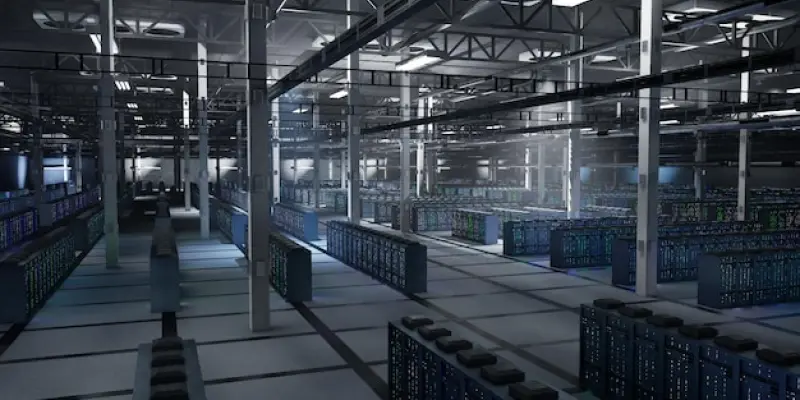In the ever-evolving landscape of digital infrastructure, the introduction of Colt Data Centre Services’ newest facility in France marks a significant milestone. Positioned southwest of Paris in Villebon-sur-Yvette, this ambitious project is a testament to Colt’s dedication to sustainability and technological advancement. As part of an extensive €2.3 billion investment in the country’s digital capabilities, the data center aims to reinforce France’s status in the digital economy. Designed to meet the demands of hyperscale and enterprise clients, the center stands out with its 40MW capacity, ensuring substantial support for companies at the forefront of technology.
Green Technologies and Sustainable Design
Harnessing Renewable Energy
The data center adopts a robust strategy centered on sustainability, deploying 100% renewable energy sources to power its operations. This commitment represents a crucial step toward minimizing the carbon footprint of large-scale data centers, which are traditionally known for their significant energy consumption. Rooftop solar installations form a part of this green initiative, showcasing how renewable technology integration can become a standard for future facilities. By promoting energy-efficient solutions, Colt DCS sets a new benchmark in the industry’s approach to environmental responsibility. The site’s capacity, planned to support over 100kW per cabinet, illustrates a remarkable blend of high performance and ecological awareness.
Innovative Cooling Solutions
A progressive approach to infrastructure often entails addressing one of the most critical challenges of data centers—efficient cooling systems. Colt Paris 2 incorporates hybrid cooling technologies and advanced liquid-to-chip mechanisms designed to optimize energy consumption and reduce waste. These innovations enable the data center to maintain operational efficiency while dramatically decreasing its water usage footprint. Remarkably, this facility is engineered to account for zero water waste even under full operational capacity. The reduction of natural resource consumption is crucial for sustainable development, reinforcing the center’s status as a model for green technology adoption. The liquid cooling technologies not only conserve energy but also enhance system performance by ensuring stable temperature management.
Economic and Community Impact
Job Creation and Economic Growth
Beyond its technological and environmental advances, the Colt project is poised to bring tangible benefits to the local economy. With the construction of the Paris 2 data center, 300 jobs are anticipated during the construction phase, complementing the 100 permanent positions that will emerge upon completion. This influx of employment opportunities significantly contributes to the region’s economic vibrancy. The project epitomizes how technological growth can align with community welfare, signaling a promising future in which digital advancements serve broader socioeconomic objectives. By intertwining infrastructural development with job creation, Colt demonstrates its commitment to positively impacting the regions where it operates.
Waste Heat Utilization and Community Service
Another striking feature of the data center is its waste heat utilization strategy. This forward-thinking approach entails recycling heat generated from facility operations and redirecting it for community use. Such initiatives can support new district heating networks, exemplifying how technology can serve practical community needs. This innovative practice aligns with global sustainability goals, offering a unique solution to energy wastage problems while benefiting local residents. The dual utilization of resources not only boosts operational efficiency within the data center but also extends its impact beyond technological confines into day-to-day community life. This recycling principle enhances community service offerings, ultimately providing a blueprint for future infrastructure projects to emulate.
Expansion and Future Insights
Growth Plans in France
Colt’s investment in French infrastructure doesn’t stop at Villebon-sur-Yvette. The broader strategy includes developing additional centers, PAR3 and PAR4, which cumulatively aim to deliver a total of 48MW. These expansions underscore a commitment to meeting the swelling demand for advanced digital and cloud services across France. With plans that stretch to new facilities nearing completion, such as PAR5 and PAR6 with their 45MW and 14.4MW capacities respectively, Colt continues to solidify its presence in this key market. These new data centers will further cement the company’s standing as a cornerstone of the digital infrastructure landscape, with ambitious completions expected in the next few years.
Meeting Rising Demand for Cloud and AI
In the rapidly changing realm of digital infrastructure, Colt Data Centre Services has marked a significant milestone with the unveiling of its newest facility in France. Situated in Villebon-sur-Yvette, just southwest of Paris, this ambitious endeavor underscores Colt’s firm commitment to sustainability and pioneering technological advancements. This project is part of a substantial €2.3 billion investment focused on enhancing France’s digital capabilities, aiming to solidify the country’s standing in the global digital economy. The data center is specifically designed to address the needs of both hyperscale and enterprise clients. With an impressive 40MW capacity, it promises to provide robust support for businesses at the leading edge of technology, ensuring they have the necessary resources to thrive in a competitive landscape. This facility not only reflects Colt’s strategic investment in the future of technology but also reinforces France’s pivotal role as a digital hub in Europe, promising to deliver excellence in service and innovation.

